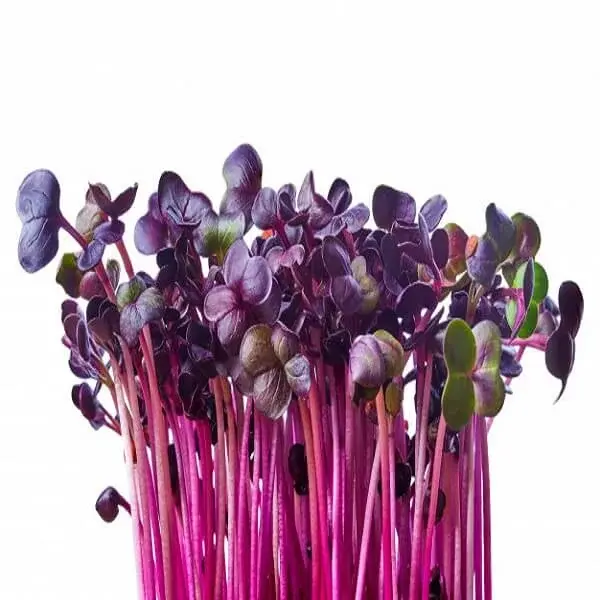Unlocking the Nutritional Potential of Microgreens: What Every Urban Farmer and Home Cook Should Know
- mikrogrens
- Jul 8
- 4 min read
Microgreens have become increasingly popular among chefs and home cooks alike. Their vibrant colors, intense flavors, and impressive nutritional profiles make them a favorite in kitchens and gardens. But, what makes microgreens so nutritious? In this blog post, we’ll explore their nutritional value, health benefits, and why you should consider adding them to your meals.
What Are Microgreens?
Microgreens are young, edible plants that are harvested just after sprouting, typically when they have developed their first set of leaves. These tiny greens can come from various plant families—including herbs and vegetables—with popular choices being arugula, radish, basil, and sunflower.
The appeal of microgreens goes beyond looks. They boast bold flavors, offering a culinary boost that can transform ordinary dishes. For example, topping a simple salad with a handful of spicy radish microgreens can elevate the entire meal. Let’s look at the nutritional facts that make microgreens a superfood choice.
Nutritional Value of Microgreens
Microgreens stand out for their extraordinary nutritional profiles. Research indicates that many varieties have significantly higher concentrations of vitamins, minerals, and antioxidants compared to their mature counterparts. In fact, studies have shown that certain microgreens can contain up to 40 times more nutrients than fully grown greens.
Vitamins in Microgreens
Microgreens are rich in essential vitamins, including:
Vitamin C: Supports immune function and skin health. For example, red cabbage microgreens can provide 6 times more vitamin C than mature cabbage.
Vitamin E: Serves as an antioxidant, protecting cells from oxidative damage. Sunflower microgreens are particularly high in this nutrient.
Vitamin K: Crucial for bone health and blood clotting. Various microgreens yield substantial amounts of vitamin K, contributing to overall well-being.
These vitamins greatly enhance the health benefits of microgreens, making them a valuable addition to any daily diet.
Antioxidants in Microgreens
Antioxidants play a critical role in reducing oxidative stress and inflammation in the body. Microgreens like broccoli and kale have high concentrations of antioxidants. For instance, broccoli microgreens can contain nearly 50 times the antioxidant content of mature broccoli. Incorporating these microgreens into your meals can provide protection against chronic diseases such as heart disease and cancer.
Furthermore, antioxidants also support skin health, making microgreens a vital component of a balanced diet.
Health Benefits of Microgreens
Heart Health
Microgreens have notable cardiovascular benefits. Varieties such as beet and arugula microgreens can lower cholesterol levels and enhance heart health. Research found that consuming beet microgreens can lead to a 13% decrease in blood pressure within just a few hours.
Weight Management
Microgreens are low in calories yet high in essential nutrients, making them perfect for those managing their weight. A one-ounce serving of microgreens typically has fewer than 50 calories but offers a concentrated array of vitamins and minerals, allowing you to add nutrition without excess calories. Their fiber content also helps you feel full, assisting in appetite control.
Enhanced Digestion
Microgreens contribute significantly to digestive health. The fiber in microgreens aids digestion and helps prevent gastrointestinal problems. Just a single ounce can provide up to 2 grams of fiber, supporting a healthy gut and overall digestive wellness.
Microgreens vs Mature Greens
People often wonder, "How do microgreens stack up against mature greens?" While both are nutritious, microgreens generally pack a more concentrated amount of nutrients. This makes them excellent for individuals looking to boost their nutrient intake without consuming large amounts of food.
Additionally, microgreens sometimes have unique flavors not found in mature greens. For example, the peppery taste of arugula microgreens can enhance salads, while the sweetness of pea shoot microgreens adds a delightful twist to stir-fries.
How to Incorporate Microgreens into Your Diet
The versatility of microgreens makes them simple to include in many meals. Here are some practical tips for incorporating microgreens into your daily dishes:
Salads: Add a handful of microgreens to your salads for a flavorful and nutritious boost.
Sandwiches and Wraps: Use microgreens as a crunchy and flavorful filling in sandwiches and wraps.
Smoothies: Blend microgreens into smoothies for an extra health kick. They will enhance nutrition without overpowering the taste.
Garnish: Use microgreens to decorate soups, omelets, and main dishes, adding color and nutrients.
Growing Microgreens at Home
If you want to try your hand at urban farming, growing microgreens at home is a rewarding and fun venture. They are easy to grow and require minimal space and equipment. Here’s how to start:
Choose Your Seeds: Pick seeds from microgreens you enjoy, like pea shoots, radish, or basil.
Prepare Your Containers: Use shallow trays or any container with drainage holes.
Soil and Water: Use quality potting soil and water the seeds thoroughly after planting.
Light and Care: Place the trays in a sunny spot or under grow lights. Keep the soil moist but not too wet.
Harvest: After 7 to 21 days, your microgreens will be ready. Use scissors to cut just above the soil line.

Final Thoughts
Microgreens are not just a culinary trend but a true nutritional powerhouse. With their rich vitamins, antioxidants, and health benefits, adding microgreens to your diet is a smart and tasty choice.
Whether you're an urban farmer exploring new crops or a home cook seeking to elevate your dishes, understanding the potential of microgreens can greatly enhance your meals. So, start experimenting with these small yet powerful greens today. You will discover why microgreens are celebrated as a superfood in kitchens everywhere. Enjoy a healthier lifestyle while getting creative in your kitchen or urban garden!




















Comments